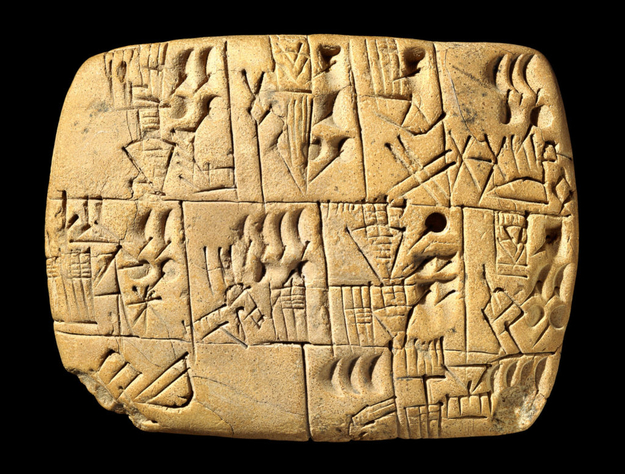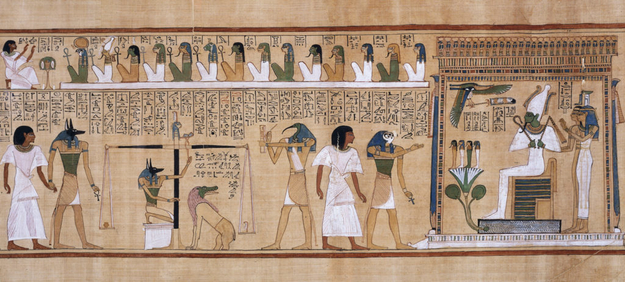Beer and libraries: the perfect mix
The Babylonians were trailblazers in many fields, including writing. This clay tablet was made around 3100–3000 BC in Mesopotamia (now southern Iraq) and features a form of writing called cuneiform. Cuneiform was some of the oldest writing in the world, but was likely created not for letters, literature or scripture, but for accountancy. This tablet records beer given to workers as part of their daily rations.
The oldest surviving royal library is also from this part of the world. Ashurbanipal, King of Assyria (r. 668–c. 630 BC), collected a library of thousands of cuneiform tablets in his palace at Nineveh. It included letters, legal texts, lists of people, animals and goods, and a wealth of scientific information, as well as myths and legends. The best known of these was the Epic of Gilgamesh, which features a great flood, prompting scholars to link the character of Utnapishtim with the Biblical Noah and his Ark.
Every picture tells a story
Usually when we think of books today, we imagine plenty of words. However, throughout history people have also used images to tell stories. This papyrus is from an ancient Egyptian ‘Book of the Dead’ belonging to a royal scribe who lived around 1200 BC. The ‘Book’ was not a single text but a compilation of spells designed to guide the deceased through the dangers of the underworld, ultimately ensuring eternal life. In this scene you can also see some hieroglyphs telling the story.
This is a scene from an incredibly rare Mixtec codex, made in Mexico before 1521. A codex is a book made up of handwritten pages. The whole document contains two narratives, starting at opposite ends of the book. The first describes the marriages and the political and military achievements of the awesomely named 11th-century ruler Lord Eight Deer Jaguar-Claw, and the second tells the history of Mixtec religious centres.
Writing on other things
Before societies became literate, stories were transmitted orally – by word of mouth, but also by putting scenes on objects. Writing began in Britain in about 50 BC – around the time of Julius Caesar’s invasion. Imitating the Romans, powerful Celtic kings who ruled in south-east England had their names put on their coins. We don’t know whether ancient Britons did much writing elsewhere – nothing has really survived, certainly no books or manuscripts – nor whether many of them were able to read what the coins said. This coin names a ruler called Verica and calls him REX – the Latin word for king. After the Romans had conquered Britain, they brought Latin with them, and a literate society. The Vindolanda tablets are a remarkable time capsule from the era of Roman rule. They were a series of letters written to and from people who lived in the fort of Vindolanda on Hadrian’s Wall. They even include a birthday party invitation! You can see a selection on display in Room 49.
Illustrating books
Some people think that The Tale of Genji was the world’s first novel. Written in AD 1007 by Murasaki Shikibu in Japan, it was still popular in the 19th century. The Hamzanama (‘Book of Hamza’), a heroic romance about the legendary adventures of the Prophet Muhammad’s uncle, Amir Hamza. The young Mughal emperor Akbar (r. 1556–1605) enjoyed listening to the tales of the Hamzanama at his court, and in 1562 he ordered his artists to produce an illustrated version. The project took more than 15 years and had over 1,400 paintings!
Western books have also been hugely associated with their illustrators. Lewis Carroll’s ‘Alice’ books were originally illustrated by John Tenniel, influencing how many thought of the stories. Perhaps one of the most famous illustrator-authors is Beatrix Potter. Her short stories and illustrations continue to prove as popular as ever thanks to the enduring charm of Peter Rabbit and Benjamin Bunny. The full set of original 1909 watercolours for ‘The Tale of the Flopsy Bunnies’ is in the Museum’s collection.
Book bling
These silver book covers once decorated the Book of Epistles and the Book of Gospels on the altar of the Minster in Ulm, Germany. The Epistles cover (on the left) has the symbols of the four Evangelists with St Antony the Hermit and St Vincent. The Gospels cover (on the right) has the Virgin and Child with St Martin, Bishop of Tours, and the Empress Helena.
During the Goryeo dynasty‘s rule in Korea (AD 918–1392), the copying of Buddhist sutras was considered to have great spiritual benefit. The handwritten copies (sagyong) were made with great skill and care in calligraphy, usually by monk-scribes. This sutra manuscript has a dazzling frontispiece, spread over two leaves, and painted in gold. It shows the historical Buddha, Shakyamuni, flanked by bodhisattvas and monks preaching to deities and other Buddhas.
A bookplate, or Ex libris, is a small print for pasting inside the cover of a book to express ownership. The first books were highly valuable and prestigious objects to own, and the first bookplates usually incorporated the coats of arms of the fabulously wealthy. By the late 19th century, bookplates had developed into a highly imaginative miniature form. This lovely book presents beautiful examples of the neglected art form by leading artists, from Dürer to Edward Burne-Jones.
Stay connected for more info and exhibit at The British Museum

